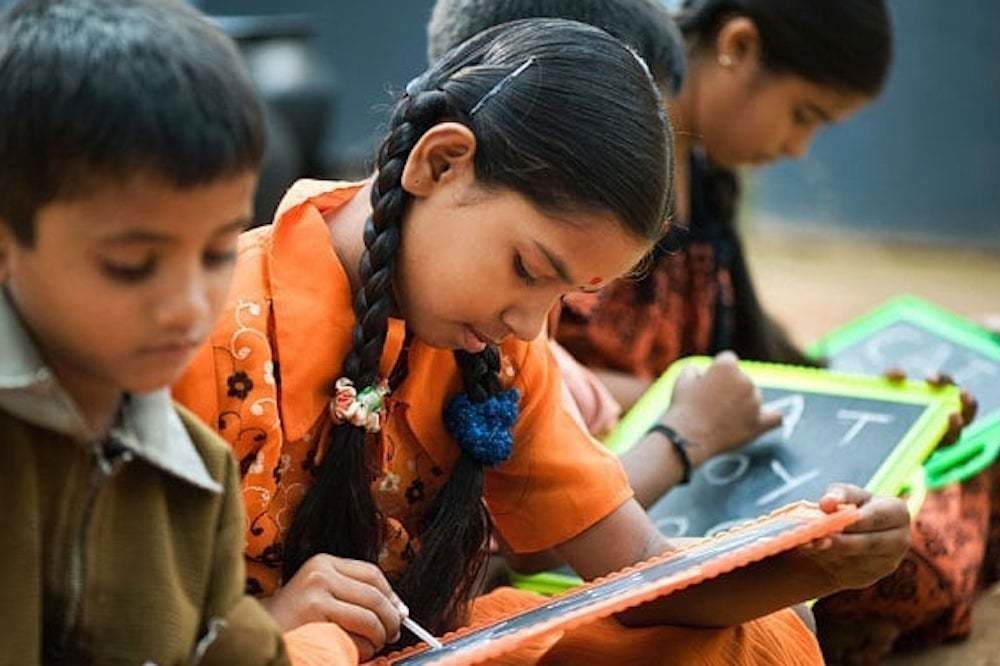Contemporary India stands at the cusp of the potential to reap a unique demographic dividend. The number of school going children between the ages of 6 to 14 years is 260 million. This is barely 10 million less than the total population of the five Scandinavian (Sweden, Finland, Norway, Denmark and Iceland) countries. The new millennium has witnessed the birth of 490 million children in India. This holds the promise of a formidable populace growing into a citizenry with capacity to turn India into a world leader in several arenas of human endeavour.
The essential component for the preparation of such an educated citizenry is basic social infrastructure of which elementary education is arguably pivotal.
Our constitution has laid down a vision for how such an social infrastructure can be actualised. It envisions building an inclusive, democratic and just society in which there would be equality of opportunity through Article 45 which promises quality equitable elementary education for all the children from 6 to 14 years of age. Even the Constitution (86th Amendment) 2002 and Right to Education (RTE) Act 2009 consequent to it, were not necessary since the constitution already promises much more than what these provisions stipulate; a fact that is often missed out in educational policy analysis.
However this constitutional promise of equitable elementary education for all the children stands abandoned at the current juncture due to the cumulative withdrawal of the state from direct delivery of school education. Even educational planners and administrators candidly admit to the historical failure of the Indian state at providing quality elementary education. There has been abdication of constitutional responsibility accompanied with a changing direction of school education policy in which a quest for equality through elementary education has been abandoned. There have also been very significant changes in school education policy making process. This article examines some of these worrying trends in school education policy-development in recent years and their consequences.
School education policy-development
In the post-independence history of educational development in our country the noteworthy Kothari Commission was constituted in July 1964 and submitted its detailed report ‘Education and National Development’ in 1968. It was on the basis of the commission’s report that the seminal though 8 page National Policy on Education (NPE), 1968 was announced. Detailed, sustained and lengthy deliberations by an expert commission were regarded as essential to the development of policy-wisdom on how to address the challenges of educating India’s children cutting across diverse socio-economic backgrounds with lot of regional disparity. The report laid emphasis on state provisioning of schools, equality in educational opportunity and viewed school education as an instrument for inclusive development.
The report’s introduction of the term ‘common school system’ in policy parlance was inspired by the uncompromising commitment of the American educator Horace Mann to promoting public education through ‘common schools’ which he believed were instruments for social integration, equity and inclusion. The report recommended an educational policy whereby free, state funded, neighbourhood schools were to be established all over the country; which all children irrespective of their socio-economic background would attend.
This policy history-legacy of thorough deliberations has since been abandoned by the Indian state. The Rajeev Gandhi lead Congress government came to office in 1985 and immediately set about the process of developing a National Policy on Education (NPE) in a bureaucratic, managerial and technocratic approach as the Human Resource Development (HRD) ministry was entrusted with formulating the NPE, 1986 which was adopted by the Parliament in May 1986 with alacrity. Educational policy development in last 4 years has followed a similar bureaucratic approach to that characterizing the development of NPE, 1986. On assuming office in 2014 the BJP government appointed a committee, which submitted the 217 page report titled as NPE, 2016 merely within a few months in May 2016. Ostensibly based on this report a 43 page document ‘Some Inputs for Draft National Education Policy, 2016 (Draft NEP, 2016) was released. There remained ambivalence on whether the two aforesaid policy-texts constituted the country’s long overdue education policy or not with the government maintaining silence on their implementation status. The HRD ministry further appointed a nine-member committee in June 2017 to further prepare another draft of a new education policy while the Press Information Bureau released a statement on 26 June 2017 that this new committee will draw from the NPE, 2016 as well as Draft NEP, 2016. Subsequent to the two committees, that worked over four years; the latter committee has formally submitted its report Draft NEP, 2019 (henceforth DNEP 2019) curiously just a day after the new BJP lead government assumed office in May 2019.
The erstwhile HRD minister Shri Prakash Javedekar in his message accompanying the release of the draft report has stated that the policy development process is an unprecedented ‘collaborative, multi-stakeholder, multi-pronged, bottom-up, people-centric, inclusive, participatory consultation’. However the 13 themes which were put up in public domain prior to formulation of NPE, 2016 for people’s comments and suggestions on topics ranging from constitutional goals of social justice, equity to protection of fundamental rights received little attention. The people’s responses on sarkari MyGov portal, which is an important link in a participatory/ people-centric policy development process; have not been made public. The government has clarified that the Draft NEP, 2019 is only a report and not official state policy and has invited feedback on the document till June 30, 2019 but news reports state that the cabinet note on the same was to be finalised by July 1, 2019.
Significantly the government think tank NITI Aayog has already laid the framework for policy development process in its 182 page ‘three year action agenda’ released in 2017. The overall direction of policy change in social infrastructure domains as indicated in the aforesaid policy text/ action agenda essentialised privatisation, non-state stakeholding and public private partnership in school education coupled with a decontexualised outcome orientation in which student learning is to be quantified, assessed and certified.
The four recent policy texts on school education: Draft NEP 2016, NEP 2016, NITI Aayog Action Agenda 2017 and DNEP 2019; reflect a historic discontinuity in policy development process moving away from the constitutional ideal of equitable school education, equality in educational opportunity and the vision of a common school system. Instead the DNEP 2019 proposes focus on setting ‘school complexes’ in district headquarters which leads to further policy-neglect of the already declining state schools ( a large number of these have already faced closure) in various parts of the country particularly backward regions.
The overall policy-trend in school education seemed to have changed in full measure to non-state stakeholding bringing school education under further privatisation, marketization and commodification.
Yet DNEP 2019 recommends that the education budget be raised to 6% of the GDP ( which each policy in post-independence India has professed but no government has practiced); the draft report in estimating the additional public expenditure required for implementing its recommendations proposes an overall 20.9% proportion of public expenditure on education per annum as opposed to current 10% annual expenditure as percentage of total expenditure by the government (estimated on the basis of 2017-18 budget estimate public expenditure figures); which has not happened in our country in the past but with political will from the top ( if PM and MHRD minister are at the helm of the proposed National Education Commission) may be a utopian possibility. Though such a major budgetary expansion is an exception (with states being cash strapped) it did happen in Delhi in February, 2015 when the Aam Aadmi Party state Government on assuming office immediately allocated Rs 9,836 crores for education which was a whopping increase of 106% over the previous government. This recommendation could turn into a vital policy strength as the state system in spite of its perceived dysfunctionality still performs its public education function by virtue of being the major part of the school education system. However this re-vitalisation of state schools cannot occur without a concerted thrust on public education, something which DNEP 2019 sorely lacks.
Worrying outcomes
School education in our society is characterised by deep structural distortions, hierarchies and inequities. The arrangements for schooling are highly differentiated along hierarchical layers that are a direct reflection of social hierarchies. This hierarchy consists of the various types of schools ranging across exclusionary high fee charging private schools, budget primary schools burgeoning from urban to rural locales, special state schools like Kendriya Vidyalayas and ordinary government schools at the bottom of the arrangement ladder. Children who attend each of these school types belong to respective differentiated social classes. Further our society has deep social divisions based on social differences of economic class, caste and regional disparity. School education is not cross cutting but overlapping with each of these social differences further exacerbating the overlapping social divisions of our society firming up social exclusions.
Against this background it is the state alone that can ensure equity and access in a burgeoning political economy of private schools; by a thrust on state provisioning which DNEP 2019 ignores. Instead it introduces ‘affordability’ as a new category of analysis when our constitution has envisioned elementary education as a free public good for all.
The Draft NEP, 2019 on the contrary uses the term a ‘quasi-public good’ to describe how economists view education. Even the godfather of mercantilism Adam Smith desisted from adding market logic to education arguing for its provisioning as a public good. However as per NITI Aayog 2017 action agenda’s new public managerialism on the deviated road of market principle (which provides framework in which Draft NEP, 2019; NPE, 2016 and Draft NEP, 2016 are located in) is akin to a new genre of policies, framed in alignment with neoliberal ideology in which the Indian state is an enthusiastic partner.
The worrying outcome of these cumulative policy-trends has been awarding legitimacy to the class basis of school education and its role in reproducing the social hierarchies. Policy concerns like common school system, inclusive education, education for equality and the value of public education in building an equitable society which were centre-stage in school education policy-texts are thrown into a crisis of legitimacy. A student of school education policy who only reads the recent four ahistorical policy texts will think of non-state stake holding under an educational policy-regime of neoliberalisation as a valid policy goal; and the neoliberal economics of Action Agenda 2017 as the interpretative framework for public policy development in the arena of social infrastructure.
For the populace of 490 million children born in India in this new millennium, the majority of whom are poor, the dream and hope of equitable school education continues to elude. So does the hope of reaping the emerging demographic dividend by turning it into an educated citizenry for the nation.
Dr. Jyoti Raina teaches at the Department of Education at Gargi College/University of Delhi .











